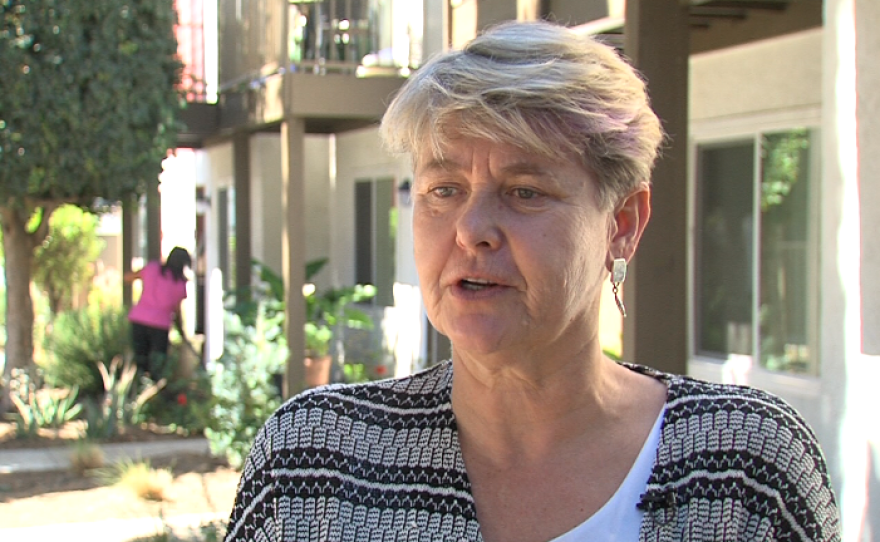While cities struggle to get approval for higher density and new affordable housing, older affordable housing is disappearing.
A new report from the nonprofit California Housing Partnership says San Diego County has lost 3,500 affordable units in the last 20 years, and in the next five years, more than 2,000 low income homes risk reverting to market rate.
The affordable units include rentals supported by HUD Section 8 housing subsidies and housing built using low income housing tax credits.
Law incentivizes affordable housing development
One reason these affordable units are disappearing is because California law requires cities to report how many new homes they plan to build for low, middle and upper income families — but there is no requirement to report how many low-income homes are being lost each year.
Almost all low-income affordable housing is built using low income housing tax credits (LIHTC). To get a tax credit, a developer must commit to rent to people who make below 60 percent of the area median income. That deed restriction lasts up to 55 years.
Anne Wilson is senior vice president of Community Housing Works, a nonprofit developer. She said affordable housing complexes are highly desirable investments for for-profit developers, if they are near the end of their allotted deed restriction.
“For the last five years, private equity, big money from Wall Street, has been very interested in buying all apartments, all rental housing," she said. “Interest rates are really low, you don’t get any return from the bank. It’s one of the safe investments, and with rents rising, they see profits there.”
But Community Housing Works sees potential there too, Wilson said. It is one of the nonprofit developers willing to go toe-to-toe with for-profits to bid for units at risk of reverting to market rate housing.
“Community Housing Works, we’re real estate developers: we have to be just as good a real estate developer, we have to do everything they do except, like Ginger Rogers, in high heels and backwards,“ Wilson said. “We have to compete with them in the market to get these, then we have to find financing to keep it affordable and we invest those profits — that for them would go to shareholders — back into renovations.”
Renters living at Manzanita, a low income housing complex in Escondido, lucked out when Community Housing Works bought their complex in 2014 for $25 million.
Manzanita in Escondido
Mariela Johnson has lived there for 15 years, and raised two daughters in a two-bedroom apartment. When she first moved in, she only had to wait a month to get into the unit. Now the waiting list for a unit in this complex is two to four years.
Johnson’s rent is just over $900 a month, and she knows she could not afford to move out: market rate rents for similar units are around $1,500.
She shows off a new sliding glass door in the kitchen and the newly-fenced small backyard. But the upgrades she appreciates the most are the ones that make her feel safe.
“Especially the gates,” she said, “that’s very important, and the security cameras. You came home late at night, it was kind of scary, but not any more.”
The security gates at the entrance to the complex were broken but are now working, and residents use access cards to get in. Every house has a light outside the door and there are security cameras in the main courtyards.
$8.3 million in renovations
Sylvia Martinez, Manzanita's project manager for Community Housing Works, said the company has spent $8.3 million on renovating the whole complex.

“We had to do a lot of systems work, the entire roof and heating air conditioning system and re-plumbed all the hot water, because the project had been experiencing leaks. We brought in a lot of green innovation: there is now domestic solar hot water, there’s solar photovoltaic that offsets not only the common area but also the tenants’ bills and utility costs.”
She gave a tour of the small community center at the center of the complex. It had been shuttered and dark for years
“The kids called it 'the haunted house,'" she said. “Because it wasn’t doing anything here. So we’ve reopened it, revitalized it, and it’s going to be full of kids, it’s going to be here for the community.”
The investment goes beyond bricks and mortar, Martinez said.
“We do work a lot with school-age kids on school success, on enrichment around literacy — which is a prime factor in knowing that kids are going to succeed in later years,” she said. “As well as computer technology access. There’s a computer room behind me. “
Before the renovations, kids had broken windows on a regular basis playing soccer between the houses. But now there’s a new fenced-in soccer field in one of the large courtyards, next to a recreation area shaded with solar panels.

If a for-profit developer had bought this apartment complex, Ann Wilson said, the $8 million CHW spent on upgrades would likely have gone to investors, as profits. The rent restrictions remaining on this low-income complex were only for another 15 years.
“So this was something that a private company would have purchased, put minimal rehab in, waited 15 years, raised the rents, effectively evicting any of the low income residents, converted it to market rate and probably sold it at a much higher profit,” Wilson said.
CHW is committed to maintaining Manzanita as an affordable housing complex for low income families for the next 55 years.
“If someone else had purchased this property, Escondido would have lost 200 really nice apartments,” Wilson said. “They weren’t that nice when we purchased them and we renovated them. But 200 families would have lost affordable housing. That’s a big number for a city of this size.”
The city of Escondido contributed $1.5 million to renovate the apartment complex. It would have cost a great deal more to build new affordable housing, Wilson said.
“It’s less expensive because you don’t have to go through community approvals and rezoning,” she explained.
It would be interesting, Wilson said, to see what would happen if California state law gave cities credit, not just for planning new projects, but also for preserving and improving their existing affordable housing.
The California Housing Partnership’s latest report says the state has lost 28,000 affordable homes in the last 20 years, and another 32,000 affordable units are at risk of converting to market rate homes in the next five years.
“There needs to be a lot of energy at the local level to save those,” Wilson said.
This story is part of a two-part series on maintaining San Diego's shrinking stock of affordable housing. Part one focuses on Oceanside's challenge to build new affordable housing faster than the city will lose older units: Oceanside, Losing Ground On Affordable Housing, Touts New Units








